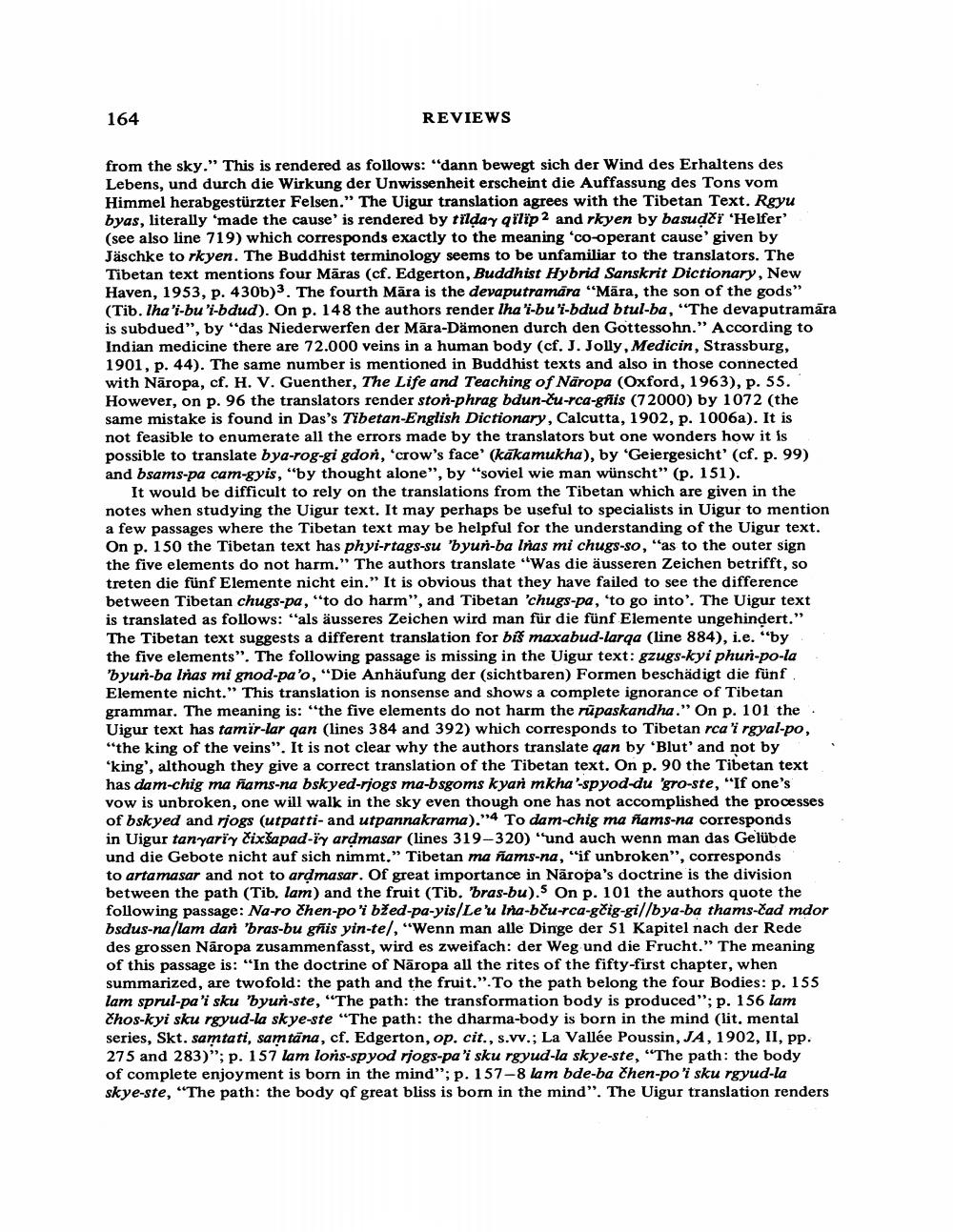________________
164
REVIEWS
from the sky." This is rendered as follows: "dann bewegt sich der Wind des Erhaltens des Lebens, und durch die Wirkung der Unwissenheit erscheint die Auffassung des Tons vom Himmel herabgestürzter Felsen." The Uigur translation agrees with the Tibetan Text. Rgyu byas, literally 'made the cause' is rendered by tilday qilip 2 and rkyen by basuḍči 'Helfer' (see also line 719) which corresponds exactly to the meaning 'co-operant cause' given by Jäschke to rkyen. The Buddhist terminology seems to be unfamiliar to the translators. The Tibetan text mentions four Māras (cf. Edgerton, Buddhist Hybrid Sanskrit Dictionary, New Haven, 1953, p. 430b)3. The fourth Mara is the devaputramāra "Māra, the son of the gods" (Tib. lha'i-bu 'i-bdud). On p. 148 the authors render lha'i-bu 'i-bdud btul-ba, "The devaputramara is subdued", by "das Niederwerfen der Mara-Dämonen durch den Gottessohn." According to Indian medicine there are 72.000 veins in a human body (cf. J. Jolly, Medicin, Strassburg, 1901, p. 44). The same number is mentioned in Buddhist texts and also in those connected with Naropa, cf. H. V. Guenther, The Life and Teaching of Naropa (Oxford, 1963), p. 55. However, on p. 96 the translators render ston-phrag bdun-ču-rca-gñis (72000) by 1072 (the same mistake is found in Das's Tibetan-English Dictionary, Calcutta, 1902, p. 1006a). It is not feasible to enumerate all the errors made by the translators but one wonders how it is possible to translate bya-rog-gi gdon, 'crow's face' (kākamukha), by 'Geiergesicht' (cf. p. 99) and bsams-pa cam-gyis, "by thought alone", by "soviel wie man wünscht" (p. 151).
It would be difficult to rely on the translations from the Tibetan which are given in the notes when studying the Uigur text. It may perhaps be useful to specialists in Uigur to mention a few passages where the Tibetan text may be helpful for the understanding of the Uigur text. On p. 150 the Tibetan text has phyi-rtags-su 'byun-ba Iñas mi chugs-so, "as to the outer sign the five elements do not harm." The authors translate "Was die äusseren Zeichen betrifft, so treten die fünf Elemente nicht ein." It is obvious that they have failed to see the difference between Tibetan chugs-pa, "to do harm", and Tibetan 'chugs-pa, 'to go into'. The Uigur text is translated as follows: "als äusseres Zeichen wird man für die fünf Elemente ungehindert." The Tibetan text suggests a different translation for bis maxabud-larqa (line 884), i.e. "by the five elements". The following passage is missing in the Uigur text: gzugs-kyi phun-po-la 'byun-ba Inas mi gnod-pa'o, "Die Anhäufung der (sichtbaren) Formen beschädigt die fünf Elemente nicht." This translation is nonsense and shows a complete ignorance of Tibetan grammar. The meaning is: "the five elements do not harm the rūpaskandha." On p. 101 the Uigur text has tamir-lar qan (lines 384 and 392) which corresponds to Tibetan rca'i rgyal-po, "the king of the veins". It is not clear why the authors translate qan by 'Blut' and not by 'king', although they give a correct translation of the Tibetan text. On p. 90 the Tibetan text has dam-chig ma ñams-na bskyed-rjogs ma-bsgoms kyan mkha'-spyod-du 'gro-ste, "If one's vow is unbroken, one will walk in the sky even though one has not accomplished the processes of bskyed and rjogs (utpatti- and utpannakrama)."4 To dam-chig ma ñams-na corresponds in Uigur tanyarïy čixšapad-iy arḍmasar (lines 319-320) "und auch wenn man das Gelübde und die Gebote nicht auf sich nimmt." Tibetan ma ñams-na, "if unbroken", corresponds to artamasar and not to arḍmasar. Of great importance in Naropa's doctrine is the division between the path (Tib. lam) and the fruit (Tib. 'bras-bu).5 On p. 101 the authors quote the following passage: Na-ro čhen-po'i bžed-pa-yis/Le'u Ina-bču-rca-gčig-gi//bya-ba thams-čad mdor bsdus-na/lam dan 'bras-bu gñis yin-te/, "Wenn man alle Dinge der 51 Kapitel nach der Rede des grossen Naropa zusammenfasst, wird es zweifach: der Weg und die Frucht." The meaning of this passage is: "In the doctrine of Naropa all the rites of the fifty-first chapter, when summarized, are twofold: the path and the fruit.". To the path belong the four Bodies: p. 155 lam sprul-pa'i sku 'byun-ste, "The path: the transformation body is produced"; p. 156 lam čhos-kyi sku rgyud-la skye-ste "The path: the dharma-body is born in the mind (lit. mental series, Skt. samtati, samtana, cf. Edgerton, op. cit., s.vv.; La Vallée Poussin, JA, 1902, II, pp. 275 and 283)"; p. 157 lam lons-spyod rjogs-pa'i sku rgyud-la skye-ste, "The path: the body of complete enjoyment is born in the mind"; p. 157-8 lam bde-ba čhen-po'i sku rgyud-la skye-ste, "The path: the body of great bliss is born in the mind". The Uigur translation renders




